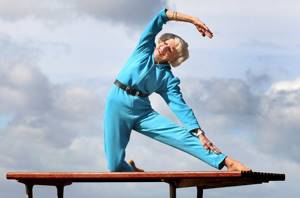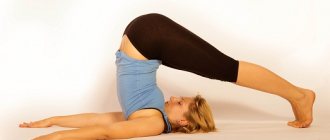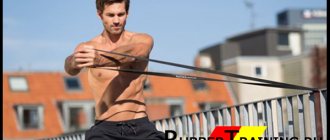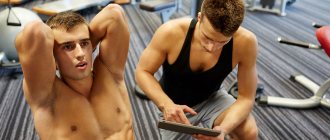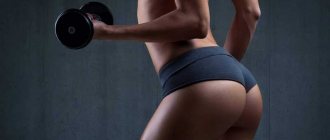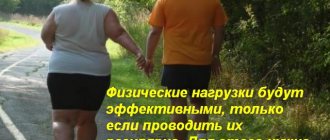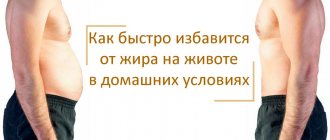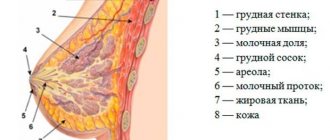Hatha yoga is the optimal practice for those who want to learn to feel their body, control it and maintain it in the desired shape.
Before learning the basic yoga poses on your own, we recommend subscribing and watching our free video lessons on the basics of yoga. Since hatha yoga consists of bodily and breathing practice, great attention at this stage is paid specifically to asanas - poses that must be taken to stretch and strengthen the muscles. Initially, you should remember just a couple of simple rules:
- The asana should be mastered from the simplest variations;
- When performing the exercise, slight discomfort or tension is possible, but not severe pain;
- You should change one asana to another smoothly, avoiding sudden movements;
- Breathing should be smooth and calm, unless otherwise provided by the rules for performing a particular pose.
You need to take care of the place of practice in advance: find an elastic and soft mat, choose light clothing that does not restrict movement, and eliminate any distractions. After a short warm-up, you can begin to master asanas: from simple to very complex.
Simple standing asanas
Tadasana
Tadasana is one of the easiest and most basic poses in hatha yoga . It is performed as simply as possible: legs are close, the weight of the body falls on the middle of the feet. It is necessary to tighten your stomach, tighten your buttocks and straighten your chest. It is important not to strain your neck or raise your shoulders. The gaze is straight, hands down, fingers together. You should breathe calmly throughout the entire asana - 30 seconds. This pose improves posture and relieves fatigue from the nervous system.
Padangustasana
Padangustasana (forward bend), exit from Tadasana. As you exhale, you need to gradually lower your straight spine forward until it is parallel to the floor. Hold for a couple of seconds, then lower even lower, reaching your toes. If stretching at this stage does not allow you to perform Padungastasana in full amplitude, then you need to linger for 15-20 seconds in the position that is now permissible.
How many poses are in yoga
There is no clear answer to the question about the number of asanas. Yes, that's fair. The world is changing. The traditions of yogic practice are also changing.
Norman Sjoman, one of the yoga researchers, came to the conclusion that modern yoga is no longer a purely Indian product, it has been transformed and modified under the influence of the West. Yoga has changed over many millennia.
Asanas have also undergone evolution. Yoga is alive as long as its traditions sprout new shoots, he said. Regardless of the number of asanas, their names and content, it is important to remember that yoga is, first of all, a system designed to purify the mind.
Advanced standing poses
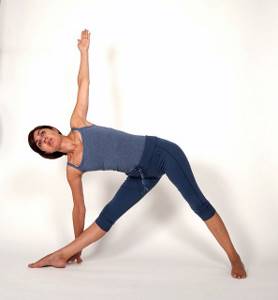
Utthita Trikonasana
Utthita Trikonasana is performed in triangle pose . While in Tadasana, you need to use a jump to change your position so that your legs are wider than your shoulders and your arms are directed to the sides. Gradually, you should turn your feet to the right side and lean to the right so that your left hand is on the outside of the foot. The gaze should be directed to the thumb of the right hand. It is important that a straight line should run from the left hand to the right. Be sure to repeat the asana on the left side.
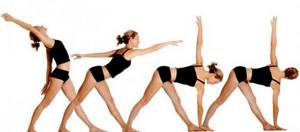
Utthita Trikonasana II
Utthita Trikonasana II is performed from the same starting position - legs apart, arms to the sides . But you should lean straight forward. After reaching parallel with the floor, you need to point your right hand down and rest on your palm. Then raise your left hand up, directing your gaze after it. It is important to maintain a straight line with your arms and not round your back.
Types of asanas
Hatha yoga includes a set of various yogic poses. They are divided into peculiar groups: standing, sitting, lying, deflections, bending, twisting, balance and revolution. In addition, poses are classified according to another property.
Some are used for stretching, others for strength and endurance. Thus, Hanumanasana from a sitting position is aimed at stretching, and Bakasana or Mayurasana is aimed at strength.
Inverted asanas improve blood circulation in the head. This is due to the fact that in this position the blood tends to the brain. The work of the digestive system also accelerates, and the tone of the internal organs increases. Such stances include Halasana and Salamba Sarvangasana.
Twists (Suchirandhasana, Parivrita Trikonasana) have a beneficial effect on the lower back and abdominal cavity.
Balancing asanas are universal and strengthen several muscles at once, and also stimulate the functioning of internal organs. These include Anantasana, Garudasana, etc.
Warrior Poses: Maximum Difficulty

Virabhadrasana I
Virabhadrasana I in hatha yoga is also performed from Tadasana . You need to raise your arms up, and then clasp your palms above your head. The legs diverge by 120-130 cm, which from the outside resembles a classic lunge. The angle between the knee should be straight, and the right thigh should be parallel to the floor. The left foot can be slightly turned to the right. The face, chest and knee should be turned in the direction of the right foot. The head is thrown back and the gaze is directed upward.

Virabhadrasana I
Virabhadrasana II is very similar to variation I, but the arms are not raised upward, but are directed to the sides . From Tadasana you need to stand in a stance with your feet wider than your shoulders. Then turn your feet to the left and lower your left knee until your thigh is parallel to the floor. The body remains straight, but the gaze is directed behind the left hand - to the left. Palms face down. It is important to maintain a straight back, keep your stomach and buttocks toned.
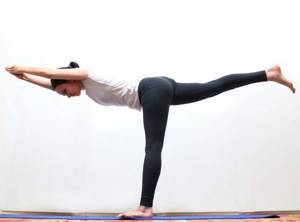
Virabhadrasana III
Yoga also includes Virabhadrasana III, which is achieved from Virabhadrasana I. To perform the exercise, you need to lower your chest onto the thigh of your front leg so that your arms are parallel to the floor. Then gradually lift your left leg off the floor, transferring the weight to your right. The knee of the supporting leg must be slowly extended until the leg becomes straight. It is enough to hold the pose for 30 seconds. When performing warrior pose, you need to repeat the exercise on both sides.
Subtleties of Virabhadrasana
It is easier to maintain balance in the warrior pose if the weight is evenly distributed on the feet. Taking the third position, you can imagine how something stretches the body by the arms and leg, which is suspended. If lower back pain prevents you from performing the asana, then you need to practice the exercise in a lighter version, resting your hands on your knee or floor.
The warrior pose in any variation strengthens the muscles of the abdominal cavity and hips, helps to establish balance and make the lower back more resistant to stress. Joint mobility also develops, which is useful for those who are interested in different types of physical activity. Virabhadrasana strengthens the hamstring muscles and allows for faster recovery from joint injuries.
Benefits of practice
Classes have a complex effect on a person:
- Well-being and physical condition improves. Pain in the back goes away, the spine becomes flexible.
- Positive changes are observed in the endocrine and digestive systems.
- Blood flow stabilizes and the elasticity of ligaments increases.
- The appearance changes. A straight posture appears, the contours of the body become clearly defined.
- Hatha yoga lessons for beginners help to escape from pressing problems, achieve spiritual harmony and happiness.
- By practicing this system, you can significantly slow down the aging process and massage your internal organs.
Balances
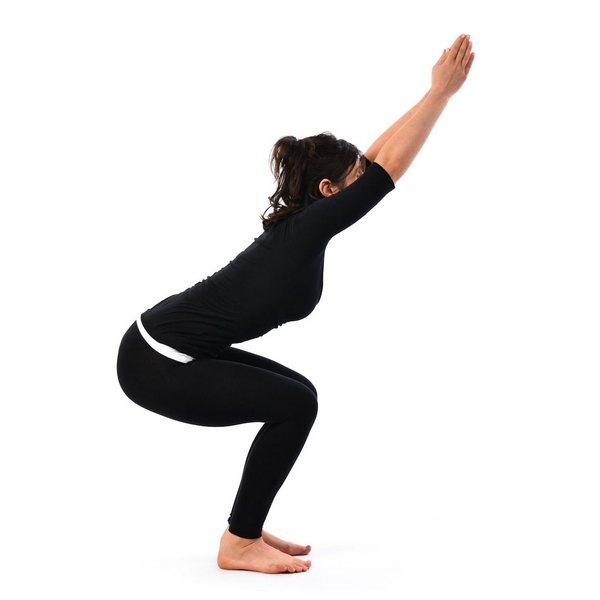
Asana “Chair” - Utkatasana
One of the simplest balances in yoga is chair pose . While in Tadasana, you need to raise your arms above your head and then slowly lower your pelvis back, bending your knees. With your knees bent at an obtuse angle, your body should be tilted forward, reaching for your arms. This is the final part of the exercise, in which you need to stay for up to 40 seconds.
In general, yoga and balances develop a sense of balance, teach you to concentrate and relax even in poses that are uncomfortable for the body. In addition, performing balances on one leg develops muscles and helps strengthen the muscle corset. It is easiest to balance when your gaze is directed at a stationary point below. The most difficult option is to be in balance with your eyes closed. An intermediate step can be looking straight ahead.
Classic balances on one leg
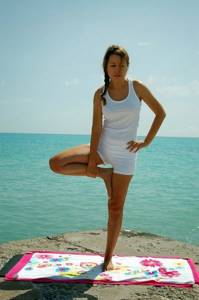
Vrksasana 1
Vrikshasana, otherwise called tree pose in hatha yoga, has two variations . To perform the first, you need to take Tadasana and pull your leg bent at the knee towards your stomach. The supporting foot should point strictly forward, and the knee should remain straight. Grasping the knee of your working leg, you should maintain the pose for up to 30-40 seconds. Exercise has a beneficial effect on the knee joint, coordination and bowel function.
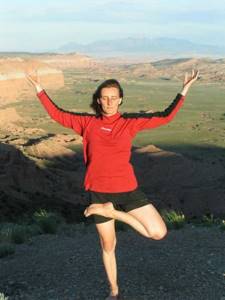
Vrikshasana 2
A more complex variation of Vrikshasana is performed from the same starting position . But now the working leg should be turned to the side and, lifting it up, pull the foot as close to the perineum as possible. If your leg slips off the inner thigh, you can support it with your hand. Otherwise, straight arms are raised up and palms are closed. The asana is performed on both sides. It is preferable to start with the leg that is worse at maintaining balance.
Complex balances on one leg

Utthita Hasta Padagushthasana 1
Utthita Hasta Padagushthasana begins with Tadasana . The right leg, as in Vrikshasana I, needs to be pulled towards you, clasping the big toe with your hands. As you exhale, you should gradually straighten your knee. The supporting leg should also remain straight. During execution, it is important to keep your abs tight and your back straight. But you should not round your lower back, so as not to harm your back. A detailed description of the pose allows you to perform it as correctly as possible.
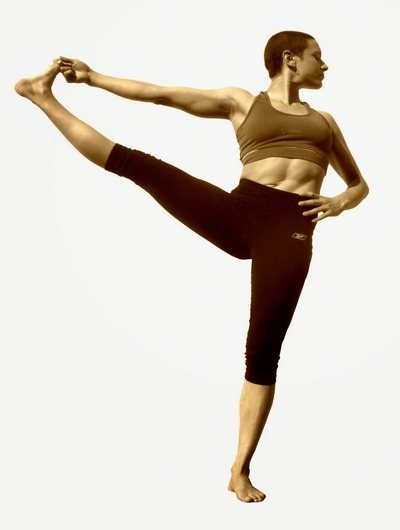
Utthita Hasta Padagushthasana 2
Utthita Hasta Padagushthasana II is also performed, but before performing it, the hip joint should be opened . The leg is straightened not in front of you, but as far as possible to the side. If you can't maintain balance, you can straighten your opposite arm. If it is still difficult, then you can rest your foot against the wall, but you should raise your arms above your head. There is another problem in developing a pose - stretching does not allow you to straighten your leg. It is worth using straps, a towel to grab the foot, or hold the foot with both hands, but under the kneecap.
Balances on hands
To increase arm strength, you need to regularly perform push-ups. In hatha yoga, women often practice push-ups on their knees. After the strength of the hands is already sufficiently developed, you can begin asanas.

Bakasana – crane pose
Bakasana is known as crane pose . First you need to squat down and place your palms on the floor in front of you. Gradually shifting the weight of the body onto your arms, you should raise your pelvis, spread your knees to the sides and place your shins behind your shoulders. Then you need to carefully tear off one foot. When this becomes easy, it’s time to transfer the weight completely to your arms and lift both legs off the floor. The middle of the back needs to be pulled up, the pelvis behind the back, and the legs behind the pelvis. You can complicate the task if you try to straighten your arms at the elbows.
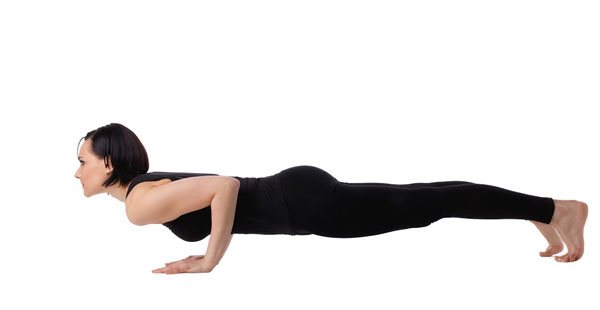
Chaturanga Dandasana
Chaturanga Dandasana is another easy arm balance variation that is worth doing to increase strength .
The starting position is the well-known plank. Then the arms need to be bent so that the forearms are parallel to the floor and the whole body is a straight line. If it is difficult to maintain this position, the knees drop to the floor.
The art and practice of hatha yoga
Yoga is the human desire to remember one's true nature, one's deepest essence. Since the beginning of the world, people have been searching for a way to transcend the human form and go beyond mere understanding. Basic questions such as: who am I? And why am I here? Fueled by the spiritual aspirations of humanity through millennia. In every human heart there is a desire to connect with something greater than oneself in order to find a sense of belonging and meaning in life. This desire is the basic human desire for happiness, which transcends culture and time. Every person wants to find it.

This desire for happiness is not a search for what exists outside of us, it is born of a desire to remember what is part of our nature. Yoga is knowledge about ourselves, our own deep purpose of existence.
Ancient science
Yoga is the message that the nature of this inner being is happiness or bliss (Ananda in Sanskrit). The search for it in the center of every human heart is the desire to discover the true nature of who we are.

No one has ever had such a need to study human nature and studied it so consistently and creatively as the people of India - a country with a huge variety of spiritual beliefs, practices and methods designed to help the spiritual quest to achieve a higher degree of consciousness.
The practice of yoga is deeply intertwined with the rich Indian culture and has evolved from the same roots as other spiritual practices. As an ancient science, it was designed to facilitate the search for the inner journey to a higher level of existence.
Yoga and religion
Although the art of yoga is often associated with Hinduism, it is not a religion. While religion emphasizes belief structures about human life and connection with the deity, hatha yoga seeks to discover and know our deepest nature without the mediation of a deity. You don't have to be religious to do yoga. There are no religious practices for her. All that is needed is a desire to learn more about yourself and your relationship with the Universe.
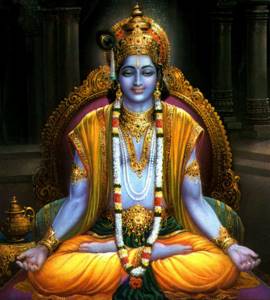
Hatha yoga is a series of physical positions or asanas that strengthen the body and make it flexible. This is much more than just physical practice. The word hatha is a combination of the Sanskrit words "ha" - sun and "tha" - moon. Properties combined with the sun: warmth, potency, strength. Properties associated with the moon: coldness, femininity, submission, surrender.
Hatha Yoga is designed to unify the incompatibilities in our heart, mind and body so that something profound can be revealed in the nature of our existence.
It establishes a bridge to grace and to such attributes as: heart, effort, courage, courage, pleasure, calm and fun. It can also be physical properties, such as: hard and soft, hot and cold, thick and liquid. The practice of yoga combines obvious opposites into a harmonious union, located somewhere in the middle.
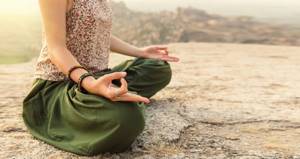
In a stream of grace
This is a transition to completely new forms for us. This is the place where we learn information about our wonderful skills and abilities of our life. They are the gateway to our hearts and where they cross, you will not be alone. Before you will be the traces of those who went before and mastered science and illuminated the path. This is a large, deep river that has brought hope and dreams to many seekers for many centuries. There is a power in her that helps on the spiritual path - the power of grace. By passing through this gate in the flow of grace, the yogi takes the first step towards achieving happiness and self-expression.
Standing forward bends
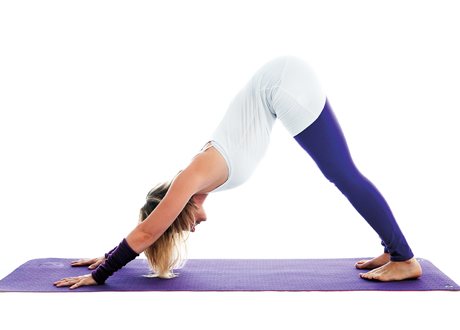
Adho Mukha Svanasana (Downward Facing Dog)
Adho Mukha Svanasana is otherwise known as downward-facing dog . The pose begins with Tadasana and subsequent Padangustasana. Then you need to take steps back one by one until the maximum tension in your legs. It is important that your knees remain straight. The feet need to be slightly turned out. Thus, the arms and back form an upward straight line, and the legs form a downward line. A tucked stomach and an upward direction of the tailbone will make the pose correct in execution.
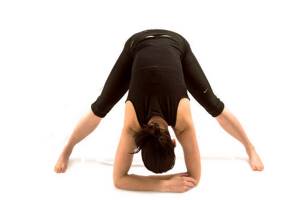
Prasarita Padattonasana 1
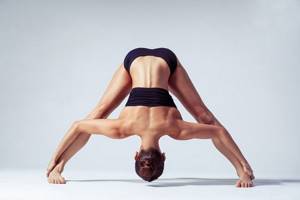
Prasarita Padattonasana 2
Prasarita Padattonasana involves the same inclination as Padangustasana, but with a wide stance . So, you need to stand in Tadasana, jump with your legs wider than your shoulders, turn your heels a little outward and bend your straight back forward. If stretching allows, then you need to clasp your ankles with your hands. Otherwise, yoga does not tolerate pain: you need to bend your arms at the elbows and place your hands on your forearms to make it easier, and in this position, stretch down. This pose is needed to stretch the legs and spine.
Simple sitting poses

Sukhasana and Stambhasana
Sukhasana is one of the simplest exercises in yoga . It is easy to perform: you need to cross your legs in front of you and stretch your arms upward with straight arms. After doing several breathing cycles, you can lower your arms, relax for a while and repeat the asana, changing the cross of your legs. Stambhasana is a slightly more complicated version. You need to not just cross your legs, but put one shin on top of the other, pressing your lower leg as much as possible to the floor. Hands should be placed on your knees. An ideal pose for performing mantras and meditation.
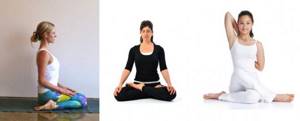
Virasana, Padmasana and Gomukhasana
Virasana is performed in this way: you need to kneel, legs slightly wider than shoulders . Hands should be placed on your knees. Then you need to slowly lower your pelvis between your feet, keeping your back straight. Padmasana is performed similarly to Sukhasana , but the legs are not simply crossed, but placed as close to the groin as possible. Gomukhasana – cow head pose . To begin, you need to sit up straight and slide your right foot under your left knee. The left thigh should be placed on the right shin, and the left shin should be placed next to the right thigh. Raise your right hand up and, bending it at the elbow, clasp it with your left hand. You need to keep your back straight.

Badhakanasana and Badha Padmasana
Badhakanasana is a seated butterfly pose . You need to sit up straight, feet together, knees pointing to the side. You can help your knees with your hands and, with light pressure, press them to the floor if stretching allows. Badha Padmasana is a more complicated version : you need to cross your legs, as in Stambhasana, and reach your feet behind your back with opposite hands.
Sitting twists

Marichiasana
Marichiasana is a pose named after the Indian sage . To repeat the pose, you need to sit up straight with your legs straight. Then pull your left leg towards you and grab it with your left hand from the inside, twisting to the right. Stay in this position for a short time, then lower yourself onto a straight leg with a straight back, stretching your chin over your knee. This pose is held for up to one minute. Twists are easier to perform if you see the pose clearly depicted in pictures.
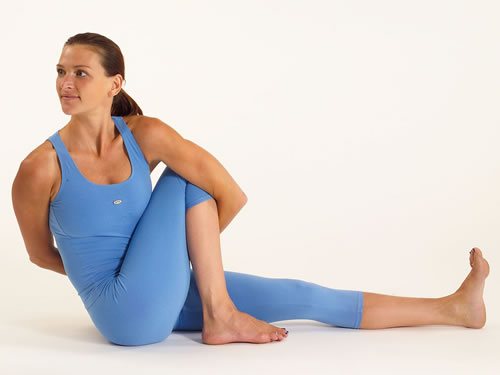
Marichiasana II
Marichiasana II is performed from the same starting position , but this time the thigh of the bent leg is grabbed by the opposite hand from the outside, and the hands are clasped behind the back.
When performing breathing cycles, you need to twist more and more to the side as you exhale and maintain the position while inhaling. Since Marichiasana can be difficult for a beginner, you can simplify it a little: in the first version, do not grab with your hands, but rest them on the floor, and in the second, grab your straight leg with your hand. After twisting in one direction, you should repeat the exercise in the other.
Bends while sitting
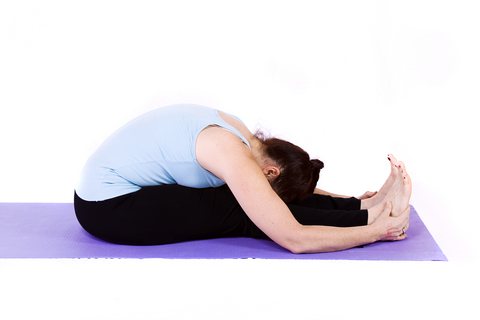
Paschimottanasana
Paschimottanasana is known to everyone who has ever done stretching . Starting position – straight back and straight legs extended forward. While inhaling, you should stretch your arms up, and as you exhale, smoothly lower them forward, grabbing your feet. It is important to keep your back straight, stretching it from vertebra to vertebra. With each exhalation you should go a little lower. At the same time, we must not forget about straight knees and a straight back: you need to lower yourself to your feet first of all with your lower abdomen. The position is held for 30-40 seconds at the lowest possible angle.

Janu Sirsasana
Janu Shirshasana resembles the previous asana, but in practice it is easier to perform .
From the starting position (sitting with your legs extended), you need to pull your right leg towards you, moving your knee to the side, and resting your foot on your thigh. Then, as you inhale, stretch up, and as you exhale, lower yourself forward, grabbing the foot of your straight leg with your hands. Here you need to pay attention to stretching: you cannot overcome severe pain, because the acceptable discomfort should be barely noticeable. Gradually, with every minute you spend in the pose, it will become easier and easier to perform the correct bend with a straight back. After performing it on the right leg, you should repeat the exercise on the left leg.
What is special about hatha yoga?
“Hatha” translated from Sanskrit means “intensity”, “effort”, and yoga means “unity”, “union”, “fusion”. This term is also considered as a word consisting of two syllables - ha tha, where ha means mind and mental energy, and the syllable tha - pranic energy, life.
Classical hatha yoga is based on performing static asanas in combination with breathing and high concentration. It is not for nothing that yoga hatha is named after two Indian names “sun” and “moon”. The description of hatha yoga is the duality of the practice. It balances both the solar and lunar energy of a person’s subtle body, helps to find balance without excesses or excesses in any direction.
For a better understanding, what distinguishes hatha yoga from yoga in general is its harmlessness in terms of energy and the risk of injury. Hatha yoga is ideal for beginners and practitioners. Once you start practicing hatha yoga, you will love this style for its simplicity and effectiveness. By practicing yoga, you will be on the path to balance and spiritual growth.
Three difficulty levels of Navasana
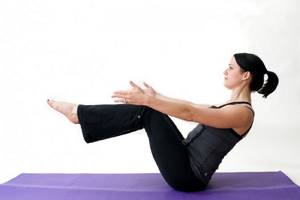
Navasana
Navasana is otherwise known as boat pose . To perform it, you need to sit with a straight back and grab your hamstrings with your hands. After this, while maintaining balance, you need to lift your feet off the floor and move your legs up so that your shins are parallel to the floor. Your arms should also be straightened next to your legs, stretching forward behind them. When it becomes easy to maintain this position, you need to lightly rest your hands on the floor and straighten your legs. It is important to ensure that the lower abdomen does not move away from the hips and that the back remains straight.

Navasana III
The third level of difficulty in Navasana involves straightening your arms until they are parallel to the floor . Balance should be maintained while performing the pose. Moreover, the support should be on the sit bones, and not the tailbone. Beginners may not raise their legs too high, but those whose body allows for a more difficult version should press their hips as much as possible into their lower abdomen, leaving their back perpendicular to the floor. After performing Navasana, you should relax your body in Sukhasana.
Basic lying poses
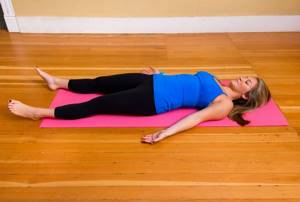
Shavasana
Savasana is included in the easiest and most famous asanas in yoga . Corpse pose usually ends a hatha yoga class - you need to lie on your back, arms at a comfortable distance from the body, muscles relaxed, and eyes closed. However, in the middle of the class you should practice other asanas that are performed lying down.
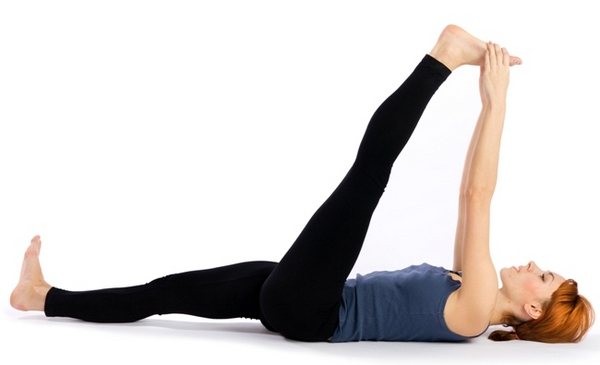
Supta Padangusthasana
The simplest of them is Supta Padangushthasana . In a lying position, you need to pull your knee to your stomach and clasp your foot with your hands. As you exhale, the leg straightens, the heel looks clearly upward. After holding this position, you need to release one hand and move your leg to the side, keeping the knee straight. The gaze is directed in the direction opposite to the leg. If there is insufficient stretch, a belt is used.
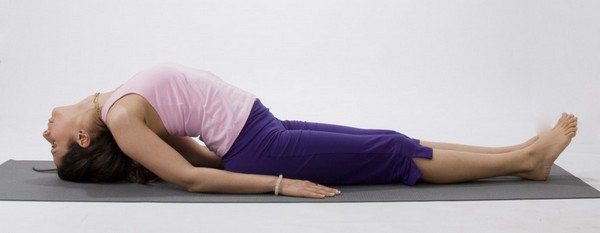
Matsiasana
Matsiasana is a pose that develops spinal flexibility . In a lying position, legs together, you need to rest your elbows on the floor, gradually lifting your back off the floor. In this case, the top of the head does not come off the surface, but the weight of the body is transferred not to the head, but to the elbows and feet. With each exhalation you need to open your chest more and more and stretch your back up. Even if the backbends have a detailed description, it is better to do them under the supervision of an instructor so as not to harm the spine.

Lying twist
The first lying twists are performed as follows : you need to lie on your back, pull your knee, clasping it with your hands, and then lower it to the floor near the opposite leg. The arms are directed to the sides, and the head is turned in the direction opposite to the knee. You can stay in this position for a few minutes, after which you should change legs. It is important that the buttocks, lower back and shoulders should not come off the mat.
Yoga practice
Yoga is enjoying unprecedented growth in popularity in the West. Almost sixteen million Americans are involved in various forms of it. Classes are offered at all levels and any style is available to choose from.
You can start your journey right from where you are today, in the style that appeals to you most.
The following description of the asanas provides detailed information on what steps you need to take to assume a particular position in the appropriate environment in order to begin to receive maximum benefits from exercise. Parts of Pranayama (yogic breathing), mantras (chanting), mudras (special positions and hand gestures), meditation, contains its own rules. Each of these methods can be useful in your life. A set of exercises taken together can completely transform your life.
Most people consider a set of yoga positions and breathing exercises to be Hatha yoga or “Sun and Moon” yoga. This is a physical yoga practice that is used to open the body and heart. But yoga is much more than that. It is an entire system with its own set of moral codes, disciplines, breathing techniques and meditation designed to enable you to take a spiritual journey.
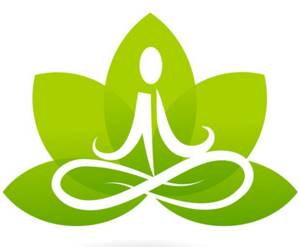
The word yoga in the traditional translation means “unification”, joining together the heart, mind and body, i.e. all parts into one connected whole.
Because a team that does everything better when all its members strive for a common goal. Then you will be at your peak when every part of your body works in harmony with the others. You are happiest when you follow your heart and do what you love.
When the heart, mind and body begin to work together, this is a step towards a surge of grace, which is called yoga. Your yoga journey is an inner quest to find the best in yourself and learn to express it every day through your body, mind and heart.
Simple inverted poses
Usually, inverted poses are left for the end of the class, because the body is already warmed up and the risk of injury is minimal. At the end of the lesson, a person will have maximum control of the body and control the muscles, making it easier to master more complex hatha yoga asanas. In general, inverted poses are beneficial for the human body. They help you relax after a working day and gain energy if performed in the morning.
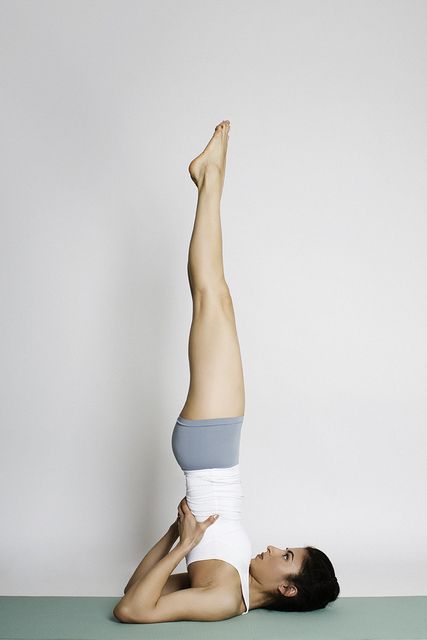
Sarvangasana
Mastering inverted poses should begin with Sarvangasana - candle pose . To perform it, lie on your back and press your thighs to your stomach. After several rolls on your back, you need to lower your palms to your lower back and gradually straighten your legs up, resting on your elbows and upper back. The neck should be maximally unloaded throughout the entire asana - one minute.
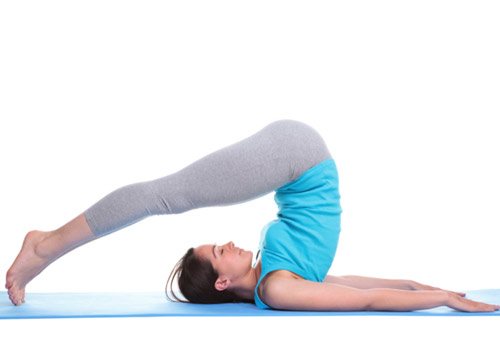
Halasana
From Sarvangasana, advanced yogis move to Halasana - plow pose . Straightened legs should be lowered behind the head and arms extended behind the back. In this case, the fingers should be intertwined with each other and turned outward. Again, the main load should fall on the shoulder joints, and not on the neck. The back should be kept straight. You can also take Halasana from a lying position with your knees pressed to your chest. After performing several rolls, you need to move your legs behind your head and straighten them. At first, your feet can rest against the wall, eventually falling lower and lower.
What does "hatha" mean?
The word "hatha" means "determination". This refers to the set of asanas and their sequence. By performing asanas, the body is aligned, muscles are toned, energy channels are opened, which have a beneficial effect on well-being and health. The concept of “hatha” is translated as: “ha” - sun and “tha” - moon.
This indicates a balance between the masculine aspect (active, hot) and the feminine aspect (sensitive, cool). Therefore, hatha yoga is a path that leads to overall balance, both in the body and in the soul. On a physical level, this means a balance between strength and flexibility, between effort and resilience. The consequence is an internal transformation of the spiritual and physical level of a person. By focusing on the breath, hatha yoga helps to stop the instability of the mind, to capture the moment: to be fully here and now.
Benefit
Hatha yoga originates from India and has been known for several thousand years as a system of discipline and physical exercise for the breath and mind. It focuses on subtle and gentle movements and breathing. Goal: to achieve unification of body and mind. Most exercises and positions, called asanas, consist of bending, turning and bending the body and act as an internal massage, regulating the actions of all body systems.
Thanks to regular hatha yoga classes:
- strengthens muscles;
- increases vitality and flexibility;
- allows you to get rid of stress;
- forms correct posture;
- improves concentration and memory;
- stimulates blood circulation;
- removes harmful substances from the body.
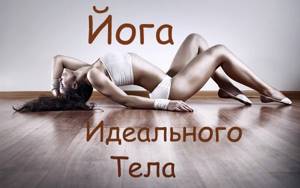
Starting to study asanas, perform breathing exercises correctly and master the art of controlled relaxation will improve your resistance to stress and clear your mind of unwanted “toxic” thoughts and emotions. Hatha yoga asanas for the back bring relief to the spine.
Quality and quantity
Even if you practice once a week, you will feel the positive effects of physical asanas. If time allows for practice more than once a week, the benefit will increase proportionally. It is best to practice 2-3 times a week. This frequency is safe for the body, which is slow to adapt to the exercise position. Over time, you will know which frequency is optimal for you, then you will begin to practice more and more, attracting more and more and more benefits. For a modern person who has a conflict between the body and emotions, hatha yoga will help overcome the limitations inherent in the body, which will give a feeling of completeness and harmony.

Hatha yoga affects all spiritual and energetic bodies of a person
Hatha yoga asanas focus on breathing and relaxation. Sometimes asanas can be combined with meditation or chanting of hymns.
There are several styles of hatha yoga:
- more or less dynamic;
- with an emphasis on physicality or spirituality.
Decide which style of yoga best suits your personality and temperament, as well as your expectations and capabilities, and go for it.
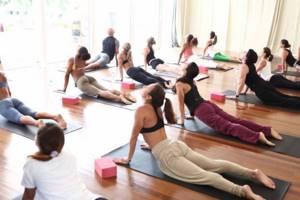
Dynamic hatha yoga for beginners will be difficult
Headstand
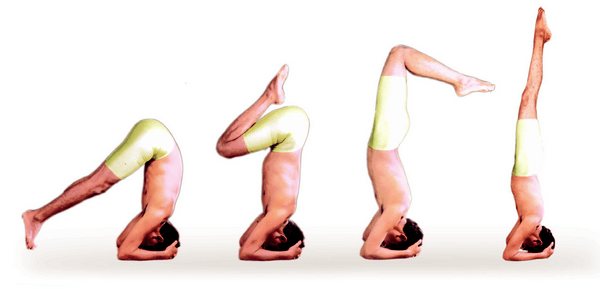
Salamba Sirsasana
Salamba Shirshasana is performed in hatha yoga, but requires the presence of an instructor . You can also master it on your own, but only after long training and after achieving a high level of physical fitness. To begin with, you should kneel and elbows, clasping the latter with your hands. Then release your hands and interlace your fingers. Place your head on the floor and straighten your legs at the knees, resting only on your toes and elbows. Stretching your tailbone up, you need to bring your feet closer to your head, pressing your hips to your stomach.
When this position becomes easy, you can move on to the next stage - lift your legs off the floor and press them bent to your body. The shoulders go as far away from the head as possible, and the main emphasis is on the elbows. Over time, this stage becomes more complicated - the legs can be straightened at the knees, pointing them upward. At first, it is enough to maintain this position for just a few breathing cycles. Over time, the headstand can be extended to 7-10 minutes. You can learn Salamba Shirshasana against a wall - this will greatly facilitate the process.
Ancient heritage of yogis
Many of the exercises and techniques used in modern yoga are quite old, while others are surprisingly young. Physical yoga is known to us as hatha, which is not even mentioned in the early texts on yoga. It has evolved all the time to meet the needs of people and time.
Many of today's Hatha Yoga exercises are no more than a hundred years old. It can be traced back to a Southern Hindu, Tirumalai Krishnamacharya, who was born in a small Indian village and was 153 cm tall. At a young age, he learned about yoga from his father and decided that he would teach others, despite the fact that at that time Hatha Yoga was not known in India. His early years were a struggle for financial survival. Then in the 1930s he got a job as a teacher in a gym at the royal palace.
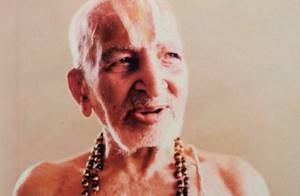
His students were mostly young, active youths, full of energy, so he had to keep them busy. Therefore, Krishnamacharya came up with a dynamic set of elements that fit into their behavior; he extracted some of the gymnastic disciplines from his old reserves, passed on to him by his father.
This series of asanas still exists today, known as Ashtanga Vinyasa Yoga. The system was popularized by one of his talented students, Rattabai Jois. Yoga was continued and further developed by another famous student of Krishnamacharya - V.K.S. Iyengar, who still teaches yoga at the age of eighty, skillfully practices the use of settings in asanas and shares them with the world.
Many former students of Iyengar are well-known instructors in the world, thanks to their abilities, constantly introducing innovations (Rodney Yee, Angela Farmer and Victor Van Houten, etc.).

Many rules for practicing yoga are based on correct body position.
These rules have helped thousands of beginners take their practice to the next level by collaborating with body, mind and heart. They are used with great success in the treatment and prevention of injuries. Medically documented:
- increasing strength and improving figure;
- reducing stress and anxiety;
- lowering blood pressure.
Many students noted that they began to feel much better if they practiced the exercises constantly.
Sun Salutation – Moon Salutation
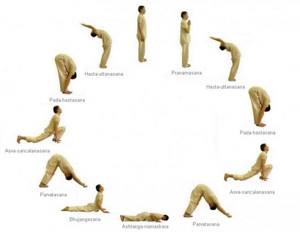
Surya Namaskar
Sun Salutation (Surya Namaskar) is a set of asanas that can be performed as a warm-up before class or morning exercises after waking up.
For lovers of evening hatha yoga, the asana complex Salutation to the Moon (Chandra Namaskar) is available, which should be performed in the evening or as a good warm-up.
You can learn more about both complexes in the next article.
Who can practice yoga and how?
By choosing to learn and practice asanas, you will become part of a larger caravan of grace with others who also want to enrich their lives and make the world a better place.
Everyone can find benefits in the practice of hatha yoga. People of different ages, different backgrounds, cultures and religions, and with different degrees of health, some with good health, while others with injuries or disabilities. For some, the path of yoga training is short, for others it becomes a passion and passion for their whole life.

There are hatha yoga exercises for everyone who has a desire to improve their health and learn to live in joy and in a place called adventure.
You can always watch the exercises performed in video mode or in pictures on the Internet.
No matter where you start, a beginner or an advanced yogi who never misses a workout, there is no doubt that you will meet people along the way who think like you.
